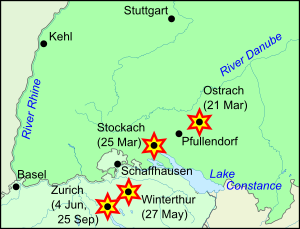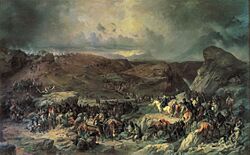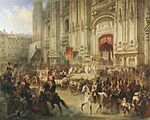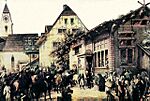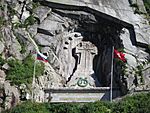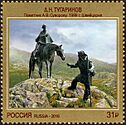Italian and Swiss expedition of 1799 facts for kids
Quick facts for kids Italian and Swiss expedition |
|||||||
|---|---|---|---|---|---|---|---|
| Part of the War of the Second Coalition | |||||||
 Map of Suvorov's campaign in Italy and Switzerland |
|||||||
|
|||||||
| Belligerents | |||||||
|
|||||||
| Commanders and leaders | |||||||
| Strength | |||||||
| ? French ? Helvetes ? Polish |
65,000 Russians ? Austrians ? Swiss rebels |
||||||
| Casualties and losses | |||||||
| in Italy: Unknown killed and wounded 80,000 captured, 3,000 cannons, 200,000 guns |
Unknown | ||||||
The Italian and Swiss expedition of 1799 was a major military campaign. It involved an army from Austria and Russia, led by the famous Russian General Alexander Suvorov. They fought against French forces in parts of modern-day Italy and Switzerland. This expedition was a key part of the War of the Second Coalition, a big conflict during the French Revolutionary Wars.
Contents
Getting Ready for Battle
The plan for this expedition was mainly made by politicians from Great Britain and Russia. Russia would send soldiers, and Britain would help pay for them. They hoped Austria would do most of the fighting, as Austria had a very large army.
Britain and Russia didn't fully trust Austria. They worried Austria wanted to gain more land. Their goal was to get Austria to fight France to protect itself and bring back the old ways of ruling in Europe.
Even though he was almost 70 years old, Suvorov was a very skilled general. He had won many battles in his long career. He was called back to lead the combined Austrian and Russian army in Italy because the Austrians specifically asked for him.
Who Fought?
Russian Soldiers
About 65,000 Russian soldiers took part in this expedition. The Russian army was split into three main groups.
- One group, led by General Alexander Korsakov, had about 24,000 soldiers. They marched from Brest-Litovsk and entered Switzerland. Their goal was to fight a French army near Zürich and then invade France.
- The second group went to Vienna, where General Suvorov joined them and took overall command. They then marched across the Brenner Pass into Italy.
- The third group, led by Andrei Rosenberg, marched from Kamenets-Podolskiy across the Carpathian Mountains to Budapest and then into Italy.
Austrian Soldiers

In August 1799, the Austrian army had about 148,663 soldiers ready for battle.
French Soldiers
The French had several armies involved:
- The Army of the Danube: This army had about 25,000 soldiers in March 1799. Its commander was General Jean-Baptiste Jourdan.
- The Army of Naples and Army of Italy: These armies had many soldiers, with their numbers changing over time. They were led by several generals, including Barthélemy Louis Joseph Schérer, Jean Victor Marie Moreau, and Barthélemy Catherine Joubert.
- The Army of the Alps: This army was created in July 1799 with 25,000 soldiers. General Jean Étienne Vachier Championnet was its commander.
- Polish Legions: These soldiers also fought alongside the French.
The Italian Campaign
General Suvorov took command on April 19. He quickly moved his army west towards the Adda River. They marched over 300 miles in just 18 days! On April 27, he defeated the French general Jean Victor Moreau at the Battle of Cassano. Suvorov then entered Milan on April 29.
Two weeks later, he moved to Turin, after defeating Moreau again at the First Battle of Marengo. The king of Sardinia welcomed Suvorov as a hero and gave him many honors.
General MacDonald marched north from Naples to help Moreau. Suvorov decided to attack MacDonald's army with all his forces. He defeated the French at the Trebbia River on June 19.
Suvorov then chased the French Army of Italy as they retreated. He captured the strong city of Mantua on July 28.
Moreau was replaced by General Barthélemy Catherine Joubert. Joubert was defeated and killed in battle with Suvorov at Novi on August 15. Years later, Moreau, who was also at Novi, said about Suvorov: "What can you say of a general so determined, who would rather die and let his army die than retreat a single step."
The Swiss Campaign
In 1798, Paul I sent General Alexander Korsakov with 30,000 men to Germany to fight France. In 1799, this force was sent to drive the French out of Switzerland. Korsakov reached Stockach in 90 days. His army then marched to Zürich to meet up with Austrian General Friedrich von Hotze's army. Hotze had already defeated the French at the Battle of Winterthur on May 27, 1799.
Suvorov's army was supposed to join them from Italy by marching through the Alps. However, the difficult mountains and enemy attacks slowed Suvorov down. Meanwhile, Korsakov waited near Zürich, feeling too confident.
The French, led by André Masséna, attacked Korsakov on September 25, 1799. They won a big victory in the Second Battle of Zürich. Korsakov had to retreat quickly. Suvorov was crossing the Devil's Bridge that very day. Korsakov eventually joined Suvorov's remaining soldiers on October 18.
What Happened Next
Suvorov managed to save his army by making a very difficult but successful march across the Alps. He didn't lose a single battle himself. However, Korsakov's defeat at the Second Battle of Zürich was a major setback. It ended any hopes of invading France.
Because of this defeat and other problems with Austria, Tsar Paul I became very angry. He pulled Russia out of the Second Coalition, and the Russian troops went home. This decision surprised many Russian leaders.
Historians believe Russia's withdrawal helped the French win the war in 1802. However, some argue that Austria still had a very strong army, so the chances for the other side weren't much worse without Russia.
Even though the French army won against the Austro-Russian forces, they didn't gain much right away. By the end of 1799, the French army in Italy was in a bad state. Soldiers were hungry, lacked supplies, and many were leaving.
When Napoleon returned to France, it briefly boosted morale. But when soldiers heard he had taken power in a coup, many were unhappy. They felt it betrayed the ideals they had been fighting for. Still, Napoleon later took control of northern Italy again in 1800.
Suvorov was called back to Saint Petersburg. He was given the highest military rank in Russian history, Generalissimo. He died in May 1800. Suvorov is still remembered in the Swiss Alps where his army marched. Even though his troops took food from the countryside, he is seen as a liberator from the French. There are plaques and monuments in his honor.
Important Battles
| Date | Battle | Region | French forces | Coalition forces | Result |
|---|---|---|---|---|---|
| 6 March 1799 | Battle of Chur | Grisons, Switzerland | French victory | ||
| 7 March 1799 | (First) Battle of Feldkirch | Vorarlberg, Austria | French victory | ||
| 20–21 March 1799 | Battle of Ostrach | Swabia, Germany | Coalition victory | ||
| 23 March 1799 | (Second) Battle of Feldkirch | Vorarlberg, Austria | Coalition victory | ||
| 25 March 1799 | Battle of Stockach | Swabia, Germany | Coalition victory | ||
| 29 March 1799 | Battle of Verona | Veneto, Italy | Draw | ||
| 5 April 1799 | Battle of Magnano | Piedmont, Italy | Coalition victory | ||
| April–July 1799 | Siege of Mantua | Lombardy, Italy | Coalition victory | ||
| 21 April 1799 | Capture of Brescia | Brescia, Northern Italy | Coalition victory | ||
| 27–28 April 1799 | Battle of Cassano | Lombardy, Italy | Coalition victory | ||
| 12 May 1799 | Battle of Bassignana | Piedmont, Italy | French victory | ||
| 16 May 1799 | First Battle of Marengo (Battle of San Giuliano) |
Piedmont, Italy | Coalition victory | ||
| 25 May 1799 | Battle of Frauenfeld | Thurgau, Switzerland | Draw | ||
| 27 May 1799 | Battle of Winterthur | Zürich, Switzerland | Coalition victory | ||
| 4–7 June 1799 | First Battle of Zurich | Zürich, Switzerland | Coalition victory | ||
| 12 June 1799 | Battle of Modena | Romagna, Italy | French victory | ||
| 17–20 June 1799 | Battle of Trebbia | Piedmont, Italy | Coalition victory | ||
| 20 June 1799 | Second Battle of Marengo (Battle of Cascina Grossa) |
Piedmont, Italy | French victory | ||
| 14–15 August 1799 | Battle of Schwyz | Schwyz, Switzerland | French victory | ||
| 14–16 August 1799 | Battle of Amsteg | Uri, Switzerland | French victory | ||
| 15 August 1799 | (First) Battle of Novi | Piedmont, Italy | Coalition victory | ||
| 18 September 1799 | Battle of Mannheim | Palatinate, Germany | Coalition victory | ||
| 24 September 1799 | Battle of Gotthard Pass | Ticino, Switzerland | Coalition victory | ||
| 25–26 September 1799 | Second Battle of Zurich | Zürich, Switzerland | French key victory | ||
| 25–26 September 1799 | Battle of Linth River | Glarus, Switzerland | French victory | ||
| 30 September – 1 October 1799 | Battle of Klöntal | Linth, Switzerland | Coalition victory | ||
| 30 September – 1 October 1799 | Battle of Muottental | Waldstätten, Switzerland | Coalition key victory | ||
| 24 October 1799 | Second Battle of Novi (Battle of Bosco) |
Piedmont, Italy | French victory | ||
| 4 November 1799 | Battle of Genola (Battle of Fossano) |
Piedmont, Italy | Coalition victory | ||
| 6 November 1799 | Third Battle of Novi | Piedmont, Italy | French victory | ||
| 3 December 1799 | Battle of Wiesloch | Baden, Germany | Coalition victory |
In Art
-
Suvorov Crossing the Devil's Bridge. Robert Porter (d. 1842).
-
1999 statue on the St. Gotthard Pass on 2016 postage stamp of Russia
See also
Sources
- Clausewitz, Carl von (2020). Napoleon Absent, Coalition Ascendant: The 1799 Campaign in Italy and Switzerland, Volume 1. Trans and ed. Nicholas Murray and Christopher Pringle. Lawrence, Kansas: University Press of Kansas. ISBN: 978-0-7006-3025-7
- Clausewitz, Carl von (2021). The Coalition Crumbles, Napoleon Returns: The 1799 Campaign in Italy and Switzerland, Volume 2. Trans and ed. Nicholas Murray and Christopher Pringle. Lawrence, Kansas: University Press of Kansas. ISBN: 978-0-7006-3034-9
- Dmitry Milyutin. The History of the War of Russia with France during the Reign of Emperor Paul I, vol. 1–9. St. Petersburg, 1852–1853.



